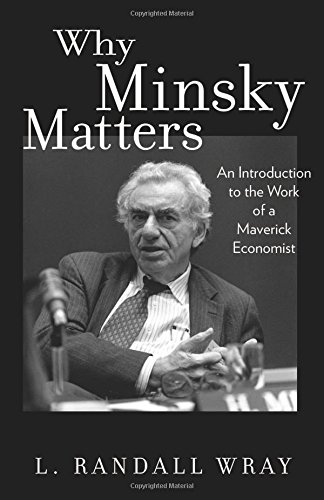A Wray of Light on Hyman Minsky
By Arnold Kling

Some of the best economics books of recent years have been written by economists about other economists. Perry Mehrling on Fischer Black.1 Robert Murphy on Ludwig von Mises.2 And now L. Randall Wray on Hyman Minsky.3 Each of the individuals profiled was far from the mainstream and yet offered important insights. Each of the authors makes an important contribution by making these insights more accessible.
Minsky had a following on Wall Street that was enlarged in the wake of the financial crisis of 2008. His theory that the financial sector makes capitalism inherently unstable meant that while orthodox economists were shocked by the end of what they called the Great Moderation, acolytes of Minsky were not so surprised. Cognoscenti were describing the crisis that erupted a dozen years after his death as a “Minsky moment.”
While L. Randall Wray also praises Minsky for his anticipation of the financial crisis of 2008, he provides a much more nuanced and complete picture of Minsky’s analytical framework than I had encountered previously. While I am not completely converted, I came away from the book with considerably more understanding of Minsky’s views and a greater respect for them.
Minsky saw himself as an economist in the Keynesian tradition. However, he differed from modern Keynesians in many important respects:
1. Orthodox Keynesians think of the financial sector in highly abstract terms, reducing it to simple equations with variables that are unaffected by the behavior of intermediaries. Minsky took very seriously the institutional details and behavioral characteristics of financial intermediaries.
2. Orthodox Keynesians do not focus on the Federal Reserve as a lender of last resort. Minsky considered this the central bank’s most important function.
3. Orthodox Keynesians believe that the Fed controls the money supply. Minsky disputed this.
4. Orthodox Keynesians do not regard the discount window (through which the Federal Reserve can make short-term loans to banks) as an important tool. Minsky viewed it as potentially very useful.
5. Orthodox Keynesians believe that government deficits help fight recessions by adding to spending through a multiplier process. Minsky thought that government deficits worked by bolstering the balance sheets of the private sector.
6. Orthodox Keynesians model the economy as tending toward equilibrium, subject to occasional disturbances. Minsky thought that the economy is inherently unstable. Indeed, he is perhaps most famous for saying that “stability breeds instability.”
7. Orthodox Keynesians believe that macroeconomic policy can provide full employment. Minsky thought that the government must act as an employer of last resort.
8. Orthodox Keynesians discarded the idea of wage and price controls after the unhappy experience of the 1970s. Minsky still saw them as a tool for fighting inflation.
For more on these topics, see Keynesian Economics, by Alan Blinder and Monetary Policy, by James Tobin in the Concise Encyclopedia of Economics. See also “Nothing Paradoxical About Thrift “, Library of Economics and Liberty, March 2, 2009.
9. Orthodox Keynesians use models in which the optimum policy turns out to be a relatively simple rule.4 In contrast, according to Wray, Minsky thought that:
Policy formation must be dynamic, always evolving to adapt to behavioral adaptations that the policy induces.5
Probably the most important way in which Minsky differed from orthodox economists is in how he viewed the financial sector. There is a sense in which Minsky viewed every individual and every business as a financial intermediary with a balance sheet.
In a modern economy, hardly any exchange takes place through barter. Instead, buyers give IOU’s to sellers. Fiat currency can be thought of as the IOU of the government. A personal check is an IOU from an individual. One hundred years ago, a bill of exchange was the IOU of a merchant. One of Minsky’s catch-phrases was “anyone can create money… the problem lies in getting it accepted.”6
The more widely accepted an IOU, the more it resembles what we call money. However, contrary to what economics textbooks say, the reserve requirements of the Federal Reserve do not constrain the ability of financial intermediaries to supply money. Money can be supplied by non-banks (think of money-market funds). Banks can evade reserve requirements through innovation (think of sweep accounts, in which large corporate customers’ checking accounts are emptied every night of excess funds, which get shifted into accounts that do not require reserves).
As the main institutions accepting IOUs, banks do play a central role in the economy. Your personal check is accepted by banks, which in turn makes it acceptable to merchants.
The intrinsic instability that Minsky so famously warned of comes from the behavior of balance sheets. After a crisis, banks and other financial intermediaries are conservative. During this stage of “hedge finance,” banks lend only to borrowers who can repay principal and interest out of expected income. Once the memories of the crisis have faded, the economy moves on to “speculative finance,” in which loans are made to borrowers who can repay interest out of expected income but not necessarily repay principal, which has to be rolled over. After the economy has experienced a period of stability in which these more speculative loans have not experienced defaults, the next stage is “Ponzi finance,” in which loans are made to borrowers who cannot even meet interest payments without taking out new loans. In the most recent financial crisis, we had reached the Ponzi stage when many mortgage borrowers could only meet their obligations by borrowing against the appreciated value of their homes, which in turn required perpetual increases in house prices.
Minsky saw the central bank as serving as a lender of last resort. This is a necessary function when a crisis occurs in order to keep the financial sector from imploding, as intermediaries lose faith in one another and stop accepting each other’s IOUs. However, the better the central bank performs this function, the longer the period of stability, and hence the greater the propensity of lenders to become lax, slipping into Ponzi finance. Hence, stability breeds instability.
Minsky saw the financial sector as dynamic, confounding regulations with innovation and adaptation. For that reason, he had less confidence than policy makers in their ability to use tools such as risk buckets and security ratings to ensure safety and soundness at banks. Unfortunately, it seems to me that as banks become more comfortable and less skeptical, regulators become equally lax. In that regard, human nature does not differentiate between private-sector and public-sector actors.
Minsky thought that if the Fed were to force banks to use the discount window when in need of short-term funding, this would permit the Fed to examine banks’ assets more closely and thus be warned of deteriorating loan quality. This is one issue on which I firmly disagree. The Fed has a supervisory role for member banks regardless of their use of the discount window. Use of the discount window is neither necessary nor sufficient to enable the Fed to monitor bank behavior.
Another Minsky proposition that I find dubious is his idea that government deficits improve the balance sheets of the private sector. This is based on the following accounting identity:
(S – I) = (G – T) + (X – M)
… where S is private domestic saving, I is private domestic investment, G is government spending, T is tax revenue, X is exports, and M is imports. Other things being equal, as the government deficit (G – T) rises, the private sector’s surplus of saving over investment rises. Minsky saw this as an improvement in private sector balance sheets, which he argued is necessary after a crisis in order to help heal the economy.
I find this problematic. In effect, Minsky is arguing that the public is better off, at least at the margin, holding more government bonds than securities backed by private capital. This does not strike me as necessarily true. In fact, when the government has built up an unsustainable set of obligations, it is almost certainly false. People are not better off holding pieces of paper that will be redeemed using debased currency if they are redeemed at all.
Wray does not indicate how Minsky connects his model of financial crises to declines in output and employment. Perhaps this is something that we should take as obvious. However, Wray points out that Minsky advocated that the government play the role of employer of last resort, which is quite different from the conventional Keynesian view that aggregated demand management is sufficient to maintain full employment.
From the standpoint of an employer of last resort, it does not matter whether unemployment is cyclical or structural. Regardless, the government steps in and offers people jobs. One possible objection to this is that the government may employ workers who otherwise would find more productive labor in the private sector. It strikes me that to avoid this, the government would have to pay a below-market wage. However, if Minsky thought in terms of a below-market wage, Wray does not report it.
A potential objection to the government serving as the employer of last resort is that it would cause inflation. Wray does indicate that Minsky addressed this, and that is where his advocacy for intervention in wage and price behavior comes in. My own view would be that serving as an employer of last resort need not require intervention in private-sector wages and prices, at least if the government wage were below market levels. With a below-market wage, the employer of last resort function strikes me as worth considering, particularly as an alternative to fiscal and monetary pump-priming as well as an alternative to benefits that discourage participation in the labor force.
“Wray quotes Minsky as saying that American economists are “well trained but poorly educated.”
Wray quotes Minsky as saying that American economists are “well trained but poorly educated.”7 They would be better educated if they thought more about the role and characteristics of financial institutions in the economy. They could start by reading Why Minsky Matters. There is much more to the book than what I have outlined here.
Perry Mehrling, Fischer Black and the Revolutionary Idea of Finance. Wiley, 2005
Robert P. Murphy, Choice, Cooperation, Enterprise, and Human Action. Independent Institute, 2015.
L. Randall Wray, Why Minsky Matters: An Introduction to the Work of a Maverick Economist. Princeton University Press, 2015.
In his article, “Monetarism,” written for the Concise Encyclopedia of Economics prior to the crisis, Bennett T. McCallum wrote, “current thinking clearly favors policy rules in contrast to ‘discretion,’ however defined'”. More recently, one of the most popular rules, the Taylor Rule, was explained and critiqued by former Federal Reserve Board Chairman Ben Bernanke in a blog post “The Taylor Rule: a Benchmark for Monetary Policy?”
Wray, page 195.
Wray, page 94.
Wray, p. 26.
For more articles by Arnold Kling, see the Archive.

